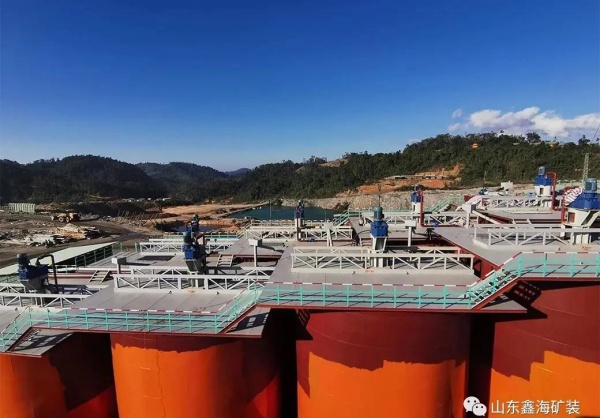If you want to know more information (such as product/process price, etc.), please contact us 24-hour telephone
In the context of increasingly scarce global gold resources, achieving efficient gold extraction through technological innovation has become a core issue in the mineral processing industry. This article systematically analyzes nine cutting-edge technologies in current gold leaching processes, combining ore characteristics and production needs to provide enterprises with solutions that ensure both economic benefits and environmental sustainability.
1.1 Carbon-in-Leach (CIL)
As a revolutionary breakthrough in cyanide leaching technology, the CIL process achieves simultaneous leaching and adsorption by directly adding activated carbon to the sodium cyanide slurry. This technology can increase gold recovery rates to over 95%, particularly suitable for fine-grained, disseminated gold ore. After implementing the CIL process in a gold mine in Inner Mongolia, the leaching cycle was reduced by 30%, and the gold loading capacity of activated carbon increased to 3000 g/t.
1.2 Oxygen-Enriched Leaching Technology
By injecting pure oxygen (O₂ concentration ≥ 95%) into the leaching system, the dissolution kinetics of cyanide are significantly improved. Production data shows that an oxygen-rich environment can enhance leaching rates by 40-60% and reduce cyanide consumption by 15-20%, making it especially suitable for processing gold ores encapsulated in sulfides.

2.1 Microbial Pre-Oxidation Process
Using acidophilic bacteria such as Acidithiobacillus ferrooxidans, sulfides are oxidized to sulfates under ambient temperature and pressure. In a low-grade gold mine in South Africa (Au 1.2 g/t), the application of bioheap leaching technology increased gold recovery from 45% with traditional methods to 82%, while operational costs were reduced by 40%.
2.2 Biological Oxidation Reactor Technology
This technology utilizes bioreactors to precisely control pH (1.5-2.0), temperature (35-45°C), and dissolved oxygen levels for continuous industrial treatment of sulfide oxidation. A single 200 m³ reactor can process up to 500 tons of ore per day, achieving three times the oxidation efficiency compared to traditional tank leaching.
3.1 Pressure Oxidation Process (POX)
Under conditions of 220-240°C and 3.5-4.5 MPa, this process rapidly decomposes sulfides using high-pressure autoclaves. After applying POX technology at a difficult-to-process gold mine in Canada, gold recovery increased from 32% with conventional methods to 94%, with a processing cycle reduced to six hours.
3.2 Acidic High-Pressure Leaching
Utilizing a sulfuric-nitric acid mixed system (H+ concentration of 2-3 mol/L) at 150°C allows for the release of gold encapsulated in arsenopyrite. This technique can process high-arsenic gold ores with As content >5%, maintaining stable recovery rates above 90%.
4.1 Column Leaching System
Employing reinforced leaching columns with diameters of 4-6 m and heights of 12-15 m, this system enhances reagent utilization rates to 98% through countercurrent spraying design. After switching to a column leaching system at a heap leach site in Chile, the leaching cycle was halved from 120 days to 60 days, with water consumption per ton of ore reduced by 35%.
4.2 Resin-in-Pulp (RIP) Method
This method replaces activated carbon with D201 type strong alkaline anion exchange resin for selective adsorption of cyanide complexes under pH conditions of 10-11. This technology exhibits five times greater tolerance to interfering elements like As and Sb, making it particularly suitable for complex polymetallic ore processing.
5.1 Flotation-Leaching Combined Process
By integrating flotation pre-concentration (with concentrate grades raised to 30-50 g/t) with CIL processes, overall ore processing volume is reduced by 60%, and reagent consumption is lowered by 45%. An Australian gold mine adopting this scheme saw total recovery costs drop to $650/oz.
5.2 Microwave Roasting Pre-treatment
Utilizing microwave radiation at 2450 MHz selectively disrupts sulfide crystal structures at temperatures between 300-500°C. Compared to traditional roasting, energy consumption is reduced by 60%, SO₂ emissions are cut by 80%, and gold exposure rates increase to 92%.
| Ore Type | Recommended Technology Combination | Expected Recovery Rate | Investment Payback Period |
|---|---|---|---|
| High Sulfide Ores | Pressure Oxidation + CIL | 92-96% | 2.5-3 years |
| Carbonaceous Ores | Microwave Roasting + Resin Adsorption | 88-92% | 2-2.5 years |
| Low-grade Oxidized Ore | Bioheap Leaching + Column Leaching | 78-85% | 1.5-2 years |
| Complex Polymetallic Ore | Flotation Enrichment + High-pressure Acid Leaching | 85-90% | 3-3.5 years |
As a professional EPCM+O service provider for mineral processing, we offer comprehensive solutions from ore characteristic analysis to process package design. Through intelligent control systems and modular equipment configurations, we can help clients achieve a gold recovery rate increase of 15-30% and reduce operational costs by 20-45%. Contact our technical team now for customized leaching process solutions and economic benefit assessment reports.